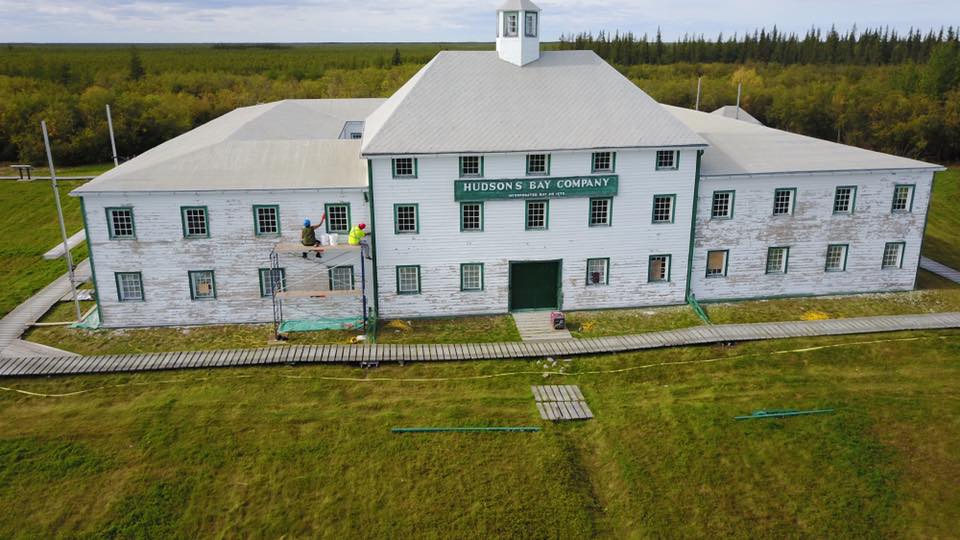Job: York Factory
Timeline: July 2017
Client: Parks Canada
North of the Hayes River, standing at two-storeys tall, is the oldest structure built on permafrost in Canada: the York Factory. Established in 1684, this fur-trading post is best known as Hudson Bay Company’s (HBC) first hubs. Despite multiple wars, raids and even enduring flooding during its reconstruction, this primary depot maintained a reputation as one of the busiest locations for traders, most of whom were Cree.
Kihciwâskâhikan or “the great house,” is the Cree name this remote historical structure, which is only accessible via canoe or seaplane and features water levels much too shallow for ships. As a traditional home to York Factory First Nation, Shamattawa First Nation, Tataskwayak First Nation and Fox Lake Cree Nation, the area holds a rich Cree history.
Advantage GRP President, Tim Hopkins, says it wasn’t unusual to see artifacts washing up on the shore of the site every day. “You could have filled a wheelbarrow full of them every few hours,” he laughs, recalling the waves bringing in canon balls and other forms of arsenal. “You have to remember there was an entire town and three wars that took place here.”
The Northern Manitoba region where the York Factory is situated is also one of the only places where polar, grizzly and black bears interact. One member of the Advantage team was designated as “bear duty” at all times, which certainly made it a more memorable project.
Working Under FHBRO
As a restoration project, the team’s main objective was to ensure the exterior of the York Factory was prepped for repainting. Because York Factory is officially recognized as a heritage building, all work fell under the strict standards and guidelines of the Federal Heritage Buildings Review Office (FHBRO).
“The biggest thing about restoration versus renovation is that you're not just pulling things out,” says former-Advantage GRP Project Manager, Adam Nelson. “You're trying to leave as much of the original as possible.”
Hopkins compares working under the guidance of FHBRO to following a detailed recipe. “You’re working with a living museum piece,” he stresses. “It’s made with very specific ingredients in a very particular way, so you need to make it exactly how it was.”
To protect the grounds from contamination, for example, tools were placed on plywood, and great care was taken to ensure it didn’t contact the existing ground. All the paint, sandpaper and techniques required approval from FHBRO first.
“We work with real artifacts and protecting them is a real art,” Tim concludes of the process.
A Case of Popeye Arms
One of the main “ingredients” under FHBRO guidelines were the 200-year-old beadboard horizontal wood sidings.
While scraping off the existing paint to prep for repainting, the Advantage team noticed that the humidity had affected the paint’s performance, resulting in delamination and rot. It indicated that testing moisture content would be necessary to prevent coating failures in repainting.
Once the building was scraped, the team proposed hand sanding the wood, taking FHBRO into account. However, due to the amount of size of the building palm sanders were approved and managed to maintain the integrity of the old panels. “We had Popeye arms by the end of it,” Hopkins laughs. “But at the end of the day, our highest compliment was that the wood still looks old but feels new.”
Because of the almost arctic conditions, there was only a small window of time to paint the building under ideal humidity levels. “Once it got colder, our five hours of painting shrunk to only about an hour or two,” explains Nelson.
A total of half the building was repainted before the season made it impossible to continue.
Before sanding and repainting
After restoration
A Connection To History
While a second phase is being proposed to complete repainting work, Hopkins says being at York Factory allowed him to see a “connecting thread” between the fur-trading hub and another project Advantage GRP completed.
“York Factory is connected to so many other historical sites,” explains Hopkins. “Including Stanley Mission’s Holy Trinity Anglican Church, which we also worked on.”
“We found out that two ships of tools and materials were sent from York Factory to Holy Trinity - and well, one of them sank,” says Tim, revealing that the workers had to melt steel and make their own nails to complete the church. “We can confirm this because we saw two different sets of nails when completing foundation work at Holy Trinity.”
Once the gateway from Europe to West Canada, York Factory now acts as a gateway to history for those willing to brave the remote climates and conditions. As an Indigenous owned and operated company, working on the York became an opportunity for Advantage GRP to revitalize a thriving Indigenous business economy, one that was a vital part of the fur trade economy then and an essential part of a modern economy today.






